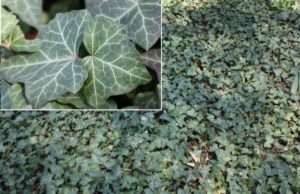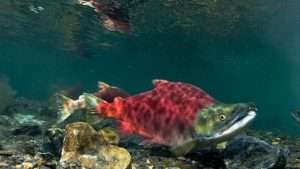 I’ve spent years battling invasive species, particularly plants, with the goal of habitat restoration. It’s an imperfect process, of course. Some of these plants can be very difficult to completely eradicate, especially if they have a deep seed bank in the soil, or if they can repopulate from tiny fragments of rhizome. Even with the best techniques, it can be difficult to impossible to return a badly damaged ecosystem to its original state, especially if we aren’t entirely sure what it looked like previously, or if certain species have been extirpated from the area. And both invasive species and climate change together make the prospect of saving native ecosystems even more daunting.
I’ve spent years battling invasive species, particularly plants, with the goal of habitat restoration. It’s an imperfect process, of course. Some of these plants can be very difficult to completely eradicate, especially if they have a deep seed bank in the soil, or if they can repopulate from tiny fragments of rhizome. Even with the best techniques, it can be difficult to impossible to return a badly damaged ecosystem to its original state, especially if we aren’t entirely sure what it looked like previously, or if certain species have been extirpated from the area. And both invasive species and climate change together make the prospect of saving native ecosystems even more daunting.
What is–and Isn’t–an Invasive Species
An invasive species is one that has been introduced to an ecosystem where it did not involve, with the result of causing greater imbalance as the invader knocks native species out of their long-held niches and upsets delicate networks of interdependency among native animals, plants, fungi, and other living beings. Some invasive plants in the United States, like kudzu (Pueraria spp.) or English ivy (Hedera helix), grow so aggressively that they take over large areas of land, leaving little to no space for native plants and the organisms reliant on them. Invasive animals may be similarly aggressive, like Burmese pythons (Python bivittatus) reducing native animal life by over 90% in some areas of Florida simply by eating them all.
In recent years, some people have been conflating these invaders from completely different areas of the world with species that are, for lack of a better term, climate change refugees. As anthropogenic climate change causes temperatures to rise, some species are no longer able to tolerate their historic homes. Some head higher in elevation; others simply move north (or south, in the Southern Hemisphere.) Animals, of course, are the first to be on the move. Plants take longer to migrate to new places on their own, especially those whose seeds aren’t spread by dispersing animals. Climate change is happening more rapidly than entire ecosystems can cope, and a large part of it is simply the logistics of migrating an entire community of beings.
So when the vanguard of migrating animals first arrives in a new area, they may not see many familiar species. But that isn’t necessarily the case. Adjacent ecosystems don’t usually have two entirely exclusive sets of biota–that is, the living beings that reside there–even if they do have some unique, even endemic, species. There are almost always some species that are found in both places, often because there are transitional areas in between that have characteristics of both. For example, look at this image of the bioregions of North America:

Notice how in between the cores of each bioregion there are transitional regions. It’s like that in smaller biogeographic divisions, too, including ecosystems and habitats. Our love of sharp defined lines and boundaries doesn’t hold up too well in nature.
So should we consider species moving northward, higher, or otherwise in response to climate change as “invasive”? I think there’s an important discussion about whether we should actually be helping species, especially plants and fungi, move northward or otherwise in response to climate change, if their native habitats have become inhospitable. But I don’t think we should refer to them as invasive, especially if it’s going to muddy the waters about truly invasive species that were artificially introduced by humans from places halfway around the world.
Truly Invasive Species and Climate Change
I’ve written a fair amount about invasive species over the years, and I wish I could say that their removal would be the only think needed to return an ecosystem to its natural state. The challenge with trying to fix any environmental problem is that it is invariably entangled with several others. Take habitat loss, for example. It’s the single biggest cause of a species becoming endangered or extinct. Many living beings can actually survive a lot of what we throw at them as long as they have an adequate habitat to retreat to. The problem is that we’ve spent centuries chipping away at natural habitats for our own gain.
 Let’s take a salmon spawning stream as an example. You can clean up the pollution in a stream and that will indeed help both the aquatic and riparian ecosystems, to include Pacific salmon that may swim up it to spawn. But if the water is full of silt from clearcutting forests upstream there are no suitable gravel banks left and any eggs that are laid will be smothered long before they can hatch out the new generation. If non-native fish like brook trout are in the water, they may eat young salmon and put further predatory pressure on them. Non-native plants like reed canary grass (Phalaris arundinacea) can change the content of riparian vegetation which reduces the young salmons’ food sources. Development along the stream can lead to further habitat degradation, especially if someone decides the stream needs to be dredged to prevent flooding so they can build in or near a historic floodplain area. And that development could lead to runoff from roads and yards, as well as other pollutants introduced into the environment, to say nothing of an increase in anglers pulling adult fish out of the water before they can successfully spawn.
Let’s take a salmon spawning stream as an example. You can clean up the pollution in a stream and that will indeed help both the aquatic and riparian ecosystems, to include Pacific salmon that may swim up it to spawn. But if the water is full of silt from clearcutting forests upstream there are no suitable gravel banks left and any eggs that are laid will be smothered long before they can hatch out the new generation. If non-native fish like brook trout are in the water, they may eat young salmon and put further predatory pressure on them. Non-native plants like reed canary grass (Phalaris arundinacea) can change the content of riparian vegetation which reduces the young salmons’ food sources. Development along the stream can lead to further habitat degradation, especially if someone decides the stream needs to be dredged to prevent flooding so they can build in or near a historic floodplain area. And that development could lead to runoff from roads and yards, as well as other pollutants introduced into the environment, to say nothing of an increase in anglers pulling adult fish out of the water before they can successfully spawn.
All those pressures add up, and invasive species are just one of many of them. When you add in global climate change, in which all ecosystems are facing unprecedented rapid changes, you increase the pressure exponentially. Even ecosystems that may seem relatively normal will be less resilient in the face of climate change due to the damage done by the other destructive factors, including invasive species.
So will removing invasive species fix everything? Of course not. What it will do, though, is remove one big source of pressure on native species. If they aren’t competing with invasives for food, shelter, and other resources–or simply being outright killed by these non-natives species–then that adds something to their resiliency, both as individuals and as bigger parts of whole systems. And as climate change is the biggest looming environmental problem of them all that’s likely to be here for centuries even under the best of circumstances, every advantage we can give native ecosystems increases the chance that at least some of the native species therein will survive the onslaught. The world may look different, and some of them may have had to migrate elsewhere to survive, but the more biodiversity we can preserve, the more adaptable ecosystems will be in the face of ecological disaster. (And it just so happens that some of the solutions for saving biodiversity are pretty good for mitigating the effects of climate change, too–win-win!)
